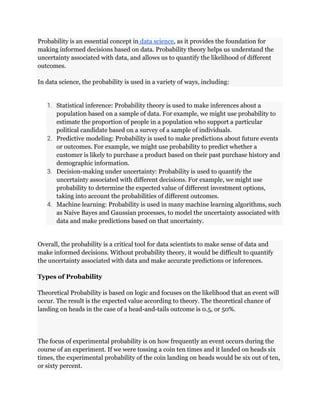
The Importance of Probability in Data Science.docx
- 1. Probability is an essential concept in data science, as it provides the foundation for making informed decisions based on data. Probability theory helps us understand the uncertainty associated with data, and allows us to quantify the likelihood of different outcomes. In data science, the probability is used in a variety of ways, including: 1. Statistical inference: Probability theory is used to make inferences about a population based on a sample of data. For example, we might use probability to estimate the proportion of people in a population who support a particular political candidate based on a survey of a sample of individuals. 2. Predictive modeling: Probability is used to make predictions about future events or outcomes. For example, we might use probability to predict whether a customer is likely to purchase a product based on their past purchase history and demographic information. 3. Decision-making under uncertainty: Probability is used to quantify the uncertainty associated with different decisions. For example, we might use probability to determine the expected value of different investment options, taking into account the probabilities of different outcomes. 4. Machine learning: Probability is used in many machine learning algorithms, such as Naive Bayes and Gaussian processes, to model the uncertainty associated with data and make predictions based on that uncertainty. Overall, the probability is a critical tool for data scientists to make sense of data and make informed decisions. Without probability theory, it would be difficult to quantify the uncertainty associated with data and make accurate predictions or inferences. Types of Probability Theoretical Probability is based on logic and focuses on the likelihood that an event will occur. The result is the expected value according to theory. The theoretical chance of landing on heads in the case of a head-and-tails outcome is 0.5, or 50%. The focus of experimental probability is on how frequently an event occurs during the course of an experiment. If we were tossing a coin ten times and it landed on heads six times, the experimental probability of the coin landing on heads would be six out of ten, or sixty percent.
- 2. Read More: Top 10 Data Science Prerequisites You Should Know in 2023 Conditional Probability The likelihood that an event or outcome will occur based on an existing event or outcome is known as conditional probability. If you work for an insurance business, for instance, you might wish to determine whether a person would likely be able to pay for his insurance given the fact that they have taken out a mortgage. By utilizing more dataset variables, conditional probability aids data scientists in creating models and outputs that are more accurate. Distribution A statistical function known as probability distribution aids in describing the potential values and probabilities for a random variable within a particular range. Statistical testing will determine where the range's potential lowest and maximum values are placed on a distribution graph. You can determine the type of distribution you are using based on the type of data used in the project. I'll divide them into discrete distribution and continuous distribution groups. Discrete Distribution When the data can only take on a small number of values or outcomes, it is said to have a discrete distribution. If you were to roll a die, for instance, your limited values would be 1, 2, 3, 4, 5, and 6.
- 3. Several discrete distribution types exist. For instance: When there is a discrete uniform distribution, every possibility is equally likely. If we roll a six-sided die as an example, there is an equal chance that it will land on 1, 2, 3, 4, or 6 - 16. The issue with discrete uniform distribution, however, is that it does not offer us pertinent facts that data scientists can use and use. Another kind of discrete distribution is the Bernoulli distribution, in which there are only two possible results for the experiment: true or false, yes or no, and 1 or 2. When flipping a coin, this can be employed; the outcome is either heads or tails. Using the Bernoulli distribution, we may subtract the chance of one result (p) from the total probability (1), which is denoted as (1-p). The discrete probability distribution known as the binomial distribution is a series of Bernoulli occurrences that may only yield one of two outcomes in an experiment: success or failure. In every experiment that has been done, the probability of flipping a coin will always be 1.5 or 12. Continuous distributions Continuous distributions have continuum outcomes as opposed to discrete distributions, which have finite outcomes. Due to the continuous nature of the data, these distributions frequently show up as a curve or a line on a graph. Since it is the most frequently utilized, the Normal Distribution is one that you may be familiar with. The values surrounding the mean are distributed symmetrically and without skew. When the data is plotted, it has the form of a bell, with the mean in the middle. For instance, traits with a normal distribution include height and IQ scores. Conclusion
- 4. You can see from the above how data scientists can use probability to learn more about data and provide answers. Data scientists can make highly wise decisions when they are aware of and comprehend the likelihood that an event will occur. Before undertaking any kind of analysis, you need to become more familiar with the data that you will be dealing with consistently. You can learn a lot from the data distribution and use that information to modify your job, method, and model to fit the data distribution. As a result, you spend less time interpreting the data, your workflow is more efficient, and your outputs are more accurate. Check out: Top Data Science Training in Bangalore